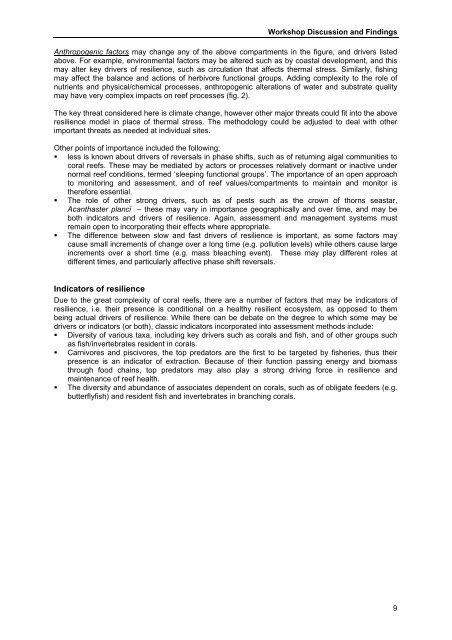Obura2009-IUCN Congress report - Resilience sessions
Obura2009-IUCN Congress report - Resilience sessions.pdf
Obura2009-IUCN Congress report - Resilience sessions.pdf
You also want an ePaper? Increase the reach of your titles
YUMPU automatically turns print PDFs into web optimized ePapers that Google loves.
Workshop Discussion and Findings<br />
Anthropogenic factors may change any of the above compartments in the figure, and drivers listed<br />
above. For example, environmental factors may be altered such as by coastal development, and this<br />
may alter key drivers of resilience, such as circulation that affects thermal stress. Similarly, fishing<br />
may affect the balance and actions of herbivore functional groups. Adding complexity to the role of<br />
nutrients and physical/chemical processes, anthropogenic alterations of water and substrate quality<br />
may have very complex impacts on reef processes (fig. 2).<br />
The key threat considered here is climate change, however other major threats could fit into the above<br />
resilience model in place of thermal stress. The methodology could be adjusted to deal with other<br />
important threats as needed at individual sites.<br />
Other points of importance included the following:<br />
• less is known about drivers of reversals in phase shifts, such as of returning algal communities to<br />
coral reefs. These may be mediated by actors or processes relatively dormant or inactive under<br />
normal reef conditions, termed ‘sleeping functional groups’. The importance of an open approach<br />
to monitoring and assessment, and of reef values/compartments to maintain and monitor is<br />
therefore essential.<br />
• The role of other strong drivers, such as of pests such as the crown of thorns seastar,<br />
Acanthaster planci – these may vary in importance geographically and over time, and may be<br />
both indicators and drivers of resilience. Again, assessment and management systems must<br />
remain open to incorporating their effects where appropriate.<br />
• The difference between slow and fast drivers of resilience is important, as some factors may<br />
cause small increments of change over a long time (e.g. pollution levels) while others cause large<br />
increments over a short time (e.g. mass bleaching event). These may play different roles at<br />
different times, and particularly affective phase shift reversals.<br />
Indicators of resilience<br />
Due to the great complexity of coral reefs, there are a number of factors that may be indicators of<br />
resilience, i.e. their presence is conditional on a healthy resilient ecosystem, as opposed to them<br />
being actual drivers of resilience. While there can be debate on the degree to which some may be<br />
drivers or indicators (or both), classic indicators incorporated into assessment methods include:<br />
• Diversity of various taxa, including key drivers such as corals and fish, and of other groups such<br />
as fish/invertebrates resident in corals.<br />
• Carnivores and piscivores, the top predators are the first to be targeted by fisheries, thus their<br />
presence is an indicator of extraction. Because of their function passing energy and biomass<br />
through food chains, top predators may also play a strong driving force in resilience and<br />
maintenance of reef health.<br />
• The diversity and abundance of associates dependent on corals, such as of obligate feeders (e.g.<br />
butterflyfish) and resident fish and invertebrates in branching corals.<br />
9


















